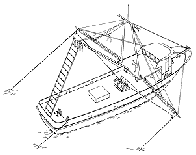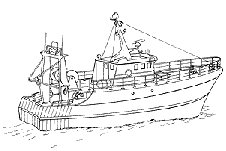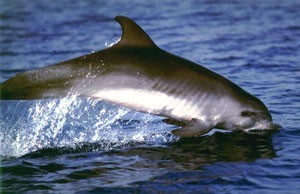|
Bottom pair trawling is a non-selective method of fishing. Non-target species, and target species of non-target sizes are taken and frequently discarded, resulting in high levels of fish discards.
http://books.nap.edu/books/0309083400/html/9.html#pagetop
These high levels of discards have a significant
impact on cetacean populations.
Evidence suggests that an increasing number of
cetaceans are malnourished due to depleted fish stocks.
April – June 2001: when 43 cetaceans were
post-mortemed in the UK, 10% were found to have
died of starvation.
(Photograph Courtesy of the Tethys Research Institute)
Regulation concerning minimum mesh size in the codend, is the most commonly used methods to limit the capture of non-target fish sizes.
Fish size selectivity has been improved by the introduction of square mesh codends and selection devices or grids.
However, selection grids have been shown to damage a proportion of both the target species and the non-target fish species.
Evidence from New Zealand suggests that these grids can and do harm marine mammals. (Department of Conservation CSL 2000/2001 Contract: Autopsy of New Zealand sea lions incidentally caught in commercial fisheries: preliminary results of cover-net trials. Progress Report 16 July 2001).
The scale of cetacean bycatch in bottom trawl fisheries is not known.
Scientific studies have focused on midwater / pelagic fisheries and gillnet fisheries, as the level of cetacean bycatch in these fisheries is known to be extremely high.
There is no compulsory monitoring system of European fishing vessels and therefore the true extent of cetacean bycatch is not known.
In the United States, the Marine Mammal Protection Act requires that fishing vessels are
monitored for levels of marine mammal bycatch, and having estimated the levels for each fishery, steps are taken to reduce the cetacean bycatch levels.
When bottom trawl fisheries in the Northwest Atlantic were monitored by US fisheries observers, it was found that a number of cetacean species were “incidentally captured” in bottom trawls: harbour porpoises, bottlenose dolphins, common dolphins, white-sided dolphins, striped dolphins, long-finned pilot whales, minke whales and sperm whales.
http://www.nmfs.noaa.gov/prot_res/PR2/Stock_Assessment_Program/individual_sars.html
It would therefore not seem too unreasonable to suggest that bottom trawl fisheries in the Northeast Atlantic, and other European waters, “incidentally capture” cetaceans.
|




